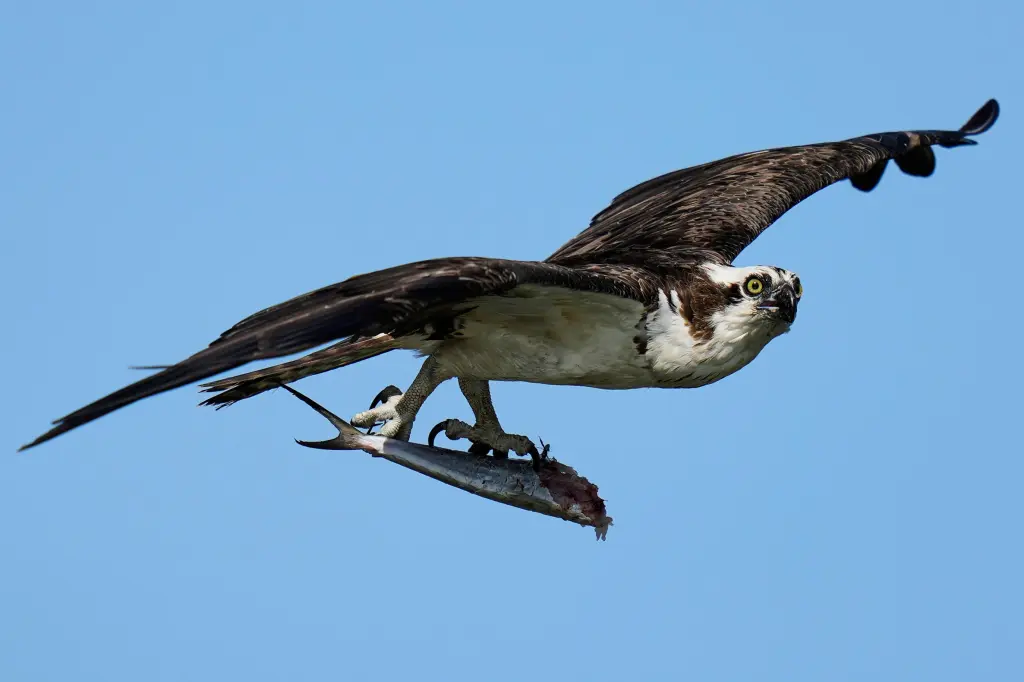Copyright Hartford Courant

The osprey population in Connecticut, once considered on the verge of extinction has seen a remarkable comeback, but numbers are now trending down from a year ago as scientists launch a study to figure out the cause, according to the Connecticut Audubon Society. The new findings are highlighted in the group’s annual State of the Birds 2025 publication entitled “Conservation Works: Building a Better Future for Birds.” This year’s publication is the Connecticut Audubon’s 20th annual Connecticut State of the Birds report. Each year, the report explores conservation issues along with possible solutions to the most pressing problems affecting Connecticut’s birds. “Every year we put out a report based on our osprey numbers from our Osprey Nation project, it looks like this year the numbers will be down from last year,” said Tom Andersen, CAS communications director and editor of the yearly report. “We’re seeing numbers more in line from two years ago. One of the things we want to figure out is whether that’s a natural fluctuation or if it means something else.” Osprey Nation, which started in 2014, is a dedicated group composed of around 400 volunteers who make it their mission to both spot and monitor the hundreds of active osprey nests around the state, Andersen said. Over the years the number of nests spotted have gone up significantly. Last year, there were over 900 active nests being monitored. But this year that number has fallen to around 800 with a noticeable drop in fledglings as well, he said. While the drop isn’t a seismic shift in the population, it’s enough to cause alarm, according to the report. “There could be various factors for why we’re seeing a population decline in Connecticut,” Andersen said. “Some possibilities are that the number of ospreys in the state have reached their capacity. There’s an idea that we’ve reached the carrying limit of their population. Once they hit a certain number, it’s harder to get food for their babies. You can’t have an infinite number of birds anywhere. Eventually they eat themselves out of the ability to grow.” “Another theory is the weather,” he said. “There were some differences in the weather that could have caused trouble with nests early in the season. We had a wet spring with lots of rain followed by drought conditions. So we’re looking at the weather data to see if that might have been a factor.” But despite the drop, Andersen said that Connecticut ospreys are doing much better than their Southern counterparts. The report’s findings document an 80% drop in the osprey population along the Chesapeake Bay in Virginia. While scientists are investigating potential causes, Andersen said it appears to be a problem with their largest food source. “In the saltwater portions of the Chesapeake, there has been an 80% failure rate for osprey nests,” Andersen said. “Fledglings are hatching but they are starving because the fish they rely on seemingly are gone. So while numbers are down in Connecticut, it is nothing like what we’re seeing in the Chesapeake.” Ospreys rely heavily on a fish called menhaden, a small, silvery saltwater fish that is rich in oils and fats. The fish are filter feeders that eat plankton and serve as a crucial food source for the predatory birds. The fish are considered highly nutritious for fledglings as well, he said. But conservationists warn that the commercial fishing of menhaden is depleting their population and causing a mass die-off of ospreys in the Chesapeake, he said. “We don’t have commercial fishing of menhaden up here in the Sound,” Andersen said. “But what we really need to figure out is what Connecticut’s ospreys are eating. We need to know if our ospreys also mostly eating menhaden or something else. So hopefully we can get some good scientific data that will not only help Connecticut’s ospreys but Chesapeake ospreys as well.” Connecticut Audubon is set to launch a pilot project in 2026 to identify the primary fish species the state’s ospreys depend on, he said. The hope is that once scientists figure out the bird’s primary source of food, they can rule that out as a cause for their decline in population. “This is purely in the realm of speculation,” Andersen said. “But there have been ancedotal reports that there are less menhaden in the Sound. We’ve heard that from recreational fisherman and folks who have fished on the Sound. Those fisherman rely on menhaden for bait and they’re saying they can’t find them. So we’re going to look into that and see if that could be a potential cause.” Because there is no commercial fishing of menhaden in the Long Island Sound, their depletion would most likely stem from their commercial fishing in the Chesapeake, if the reports turn out to be true, Andersen said. The report also recommends “stronger shorebird protection across the state, the restoration of federal funding for conservation research, and the adoption of bird-friendly building practices in cities throughout the state.” Andersen said that continued development and loss of bird habitat is among the largest factor for mass bird die-offs. In Connecticut, the Macedonia Forest Block in Kent offers the largest uninterrupted natural bird habitat in the state and is among the most important areas for bird migration, according to the report. “We urge fisheries and coastal ecosystem managers to incorporate Osprey data—reproductive success, diet, and population trends—into decision-making. Ospreys are ideal ecological indicators. Leveraging their role as bioindicators can help transform long-standing fishery debates into transparent, science-driven conservation,” the report said. The entire annual State of the Birds 2025 can be accessed here. More information on the osprey population and the new study set to be launched next year can be found here. Stephen Underwood can be reached at sunderwood@courant.com



